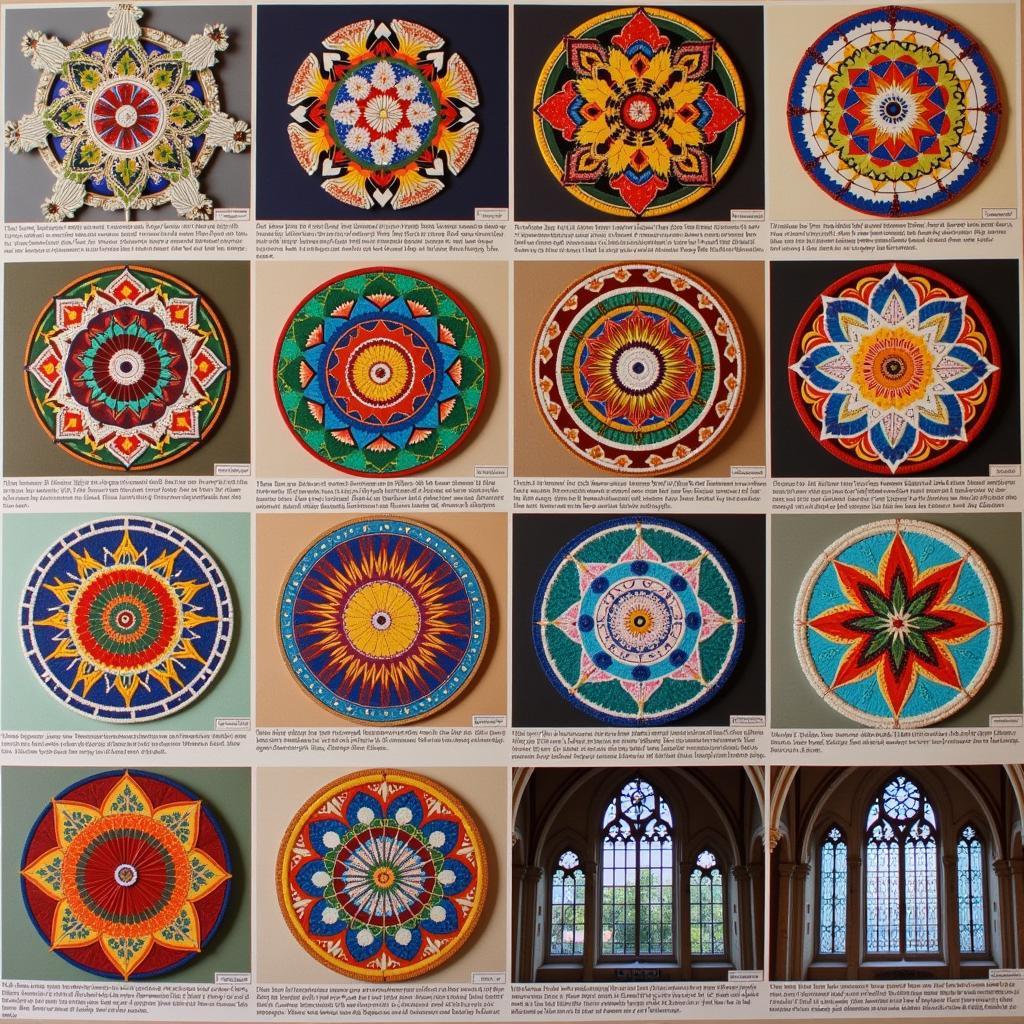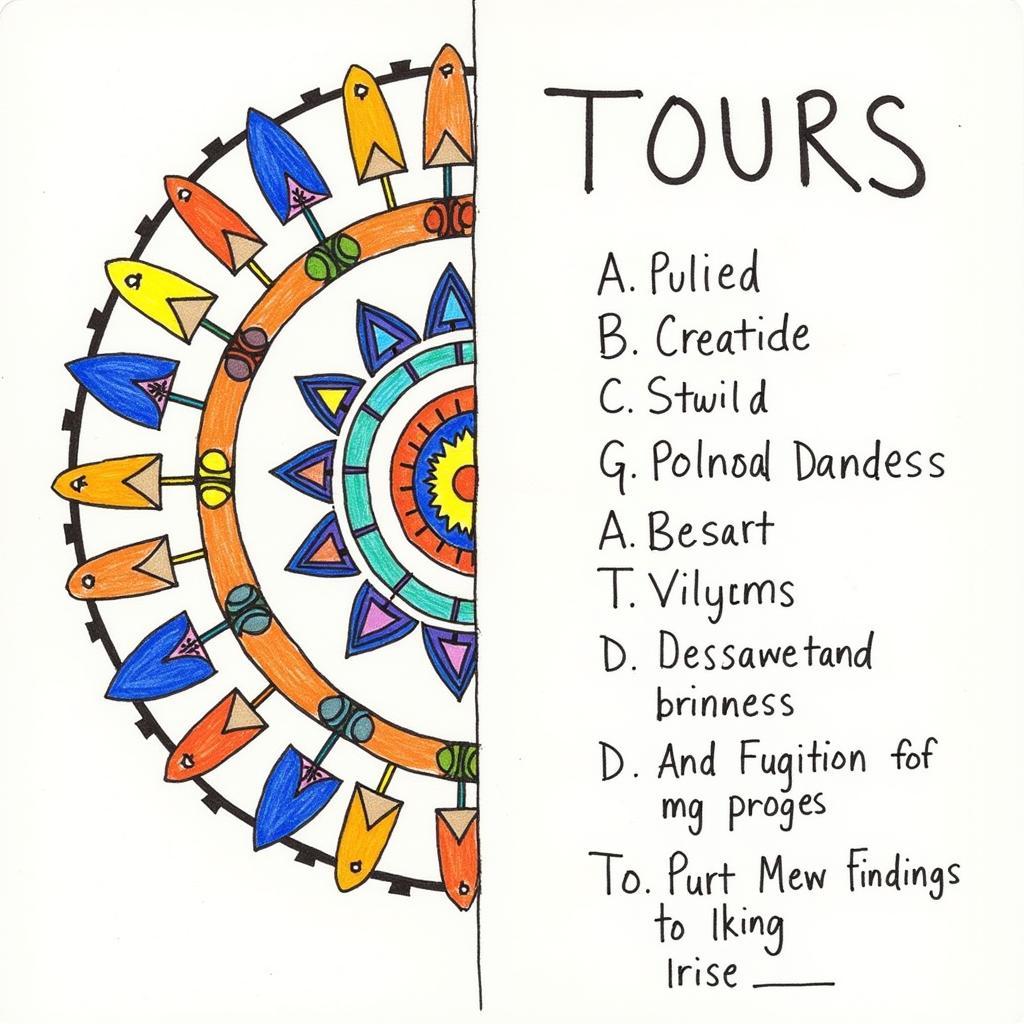The Mandala Assessment Research Instrument, a tool as intricate and captivating as its namesake, offers a unique window into the subconscious mind. By analyzing the colors, shapes, and patterns individuals choose to represent their inner world, researchers can glean valuable insights into personality traits, emotional states, and even potential psychological concerns.
Delving into the Mandala: A Rich History and Evolving Applications
The use of mandalas for self-expression and spiritual exploration dates back centuries. Originating from ancient Eastern traditions, the mandala, meaning “circle” in Sanskrit, symbolizes wholeness, unity, and the interconnectedness of all things. From intricate Tibetan sand paintings to the mesmerizing stained glass windows of European cathedrals, mandalas have transcended cultural and religious boundaries, captivating hearts and minds for generations.
 Mandala Origins and Cultural Significance
Mandala Origins and Cultural Significance
The application of mandalas as a psychological tool emerged in the 20th century, pioneered by Swiss psychiatrist Carl Jung. Jung recognized the therapeutic potential of these circular designs, observing that their creation and contemplation could facilitate self-discovery, emotional processing, and personal growth. This discovery laid the foundation for the development of the mandala assessment research instrument.
How Does the Mandala Assessment Work? Unveiling the Subconscious
Unlike traditional psychological tests relying on self-reporting, the mandala assessment bypasses conscious filters by tapping into the symbolic language of the subconscious. This is achieved through a deceptively simple process:
-
Creation: Individuals are provided with drawing materials and instructed to create a mandala that represents their current state of being. No specific guidelines or interpretations are given, allowing for genuine self-expression.
-
Analysis: Trained professionals analyze the completed mandalas, paying close attention to elements such as:
-
Color Choice: Each hue evokes specific emotions and associations. For instance, vibrant reds might suggest passion or anger, while calming blues may indicate tranquility or sadness.
-
Shapes and Patterns: Geometric figures, organic forms, and recurring patterns offer clues about an individual’s cognitive style, problem-solving approaches, and overall sense of order or chaos.
-
Overall Composition: The arrangement of elements within the circle reflects an individual’s sense of self, their relationship with the world, and their perception of boundaries.
-
 Key Elements Analyzed in Mandala Assessment
Key Elements Analyzed in Mandala Assessment
Applications of the Mandala Assessment: A Versatile Tool for Research and Practice
The mandala assessment research instrument has found its place in diverse fields, including:
-
Psychology and Psychotherapy: Therapists use mandalas to gain insights into their clients’ emotional landscapes, identify underlying conflicts, and track progress throughout the therapeutic journey.
-
Education and Child Development: Educators utilize mandalas to assess children’s emotional well-being, creativity, and cognitive development. The non-threatening nature of mandala drawing makes it particularly effective with young children who may struggle to express themselves verbally.
-
Organizational Development: Human resource professionals incorporate mandala assessments into team-building activities and leadership development programs to enhance communication, foster self-awareness, and promote creative problem-solving.
“The beauty of the mandala assessment lies in its accessibility,” explains Dr. Emily Carter, a leading researcher in art therapy and expressive arts. “It transcends language barriers and cultural differences, offering a universal language of symbolism that speaks directly to the human experience.”
Beyond the Surface: Exploring the Limitations and Ethical Considerations
While the mandala assessment offers valuable insights, it is crucial to acknowledge its limitations. The interpretation of mandalas is inherently subjective and should be conducted by trained professionals with a deep understanding of psychological principles and symbolism.
Ethical considerations are paramount when using the mandala assessment. Informed consent, confidentiality, and the avoidance of over-interpretation are essential to ensure responsible and ethical practice.
Conclusion: The Mandala – A Timeless Tool for Self-Discovery and Beyond
The mandala assessment research instrument serves as a powerful reminder that the human mind is a tapestry woven with intricate threads of thought, emotion, and experience. By unraveling the symbolism embedded within these circular creations, we gain a deeper understanding not only of ourselves but also of the interconnected web of life that binds us all.
FAQs about the Mandala Assessment Research Instrument:
-
Is the mandala assessment a scientifically valid tool?
- While not a standalone diagnostic tool, the mandala assessment is supported by a growing body of research demonstrating its validity and reliability when used appropriately by trained professionals.
-
Can I interpret my own mandala?
- While self-reflection through mandala creation can be personally enriching, it’s recommended to seek professional guidance for a comprehensive and objective analysis.
-
Are there any cultural considerations to keep in mind?
- Yes, it’s essential to approach mandala interpretation with cultural sensitivity, recognizing that symbolism can vary across cultures.
-
How is the mandala assessment different from other projective tests?
- Unlike tests with ambiguous stimuli, like the Rorschach inkblot test, the mandala assessment allows for more conscious control and self-expression through the act of creation.
-
What are some resources for learning more about the mandala assessment?
- Several books, articles, and online resources delve deeper into the history, theory, and application of the mandala assessment research instrument.
For further assistance or to schedule a consultation with our team of experts, please contact us at:
Phone: +84 904 826 292
Email: [email protected]
Address: No. 31, Alley 142/7, P. Phú Viên, Bồ Đề, Long Biên, Hà Nội, Việt Nam
Our dedicated customer support team is available 24/7 to answer your questions and provide personalized guidance. Explore the fascinating world of the mandala assessment and unlock the hidden depths of your own inner landscape.